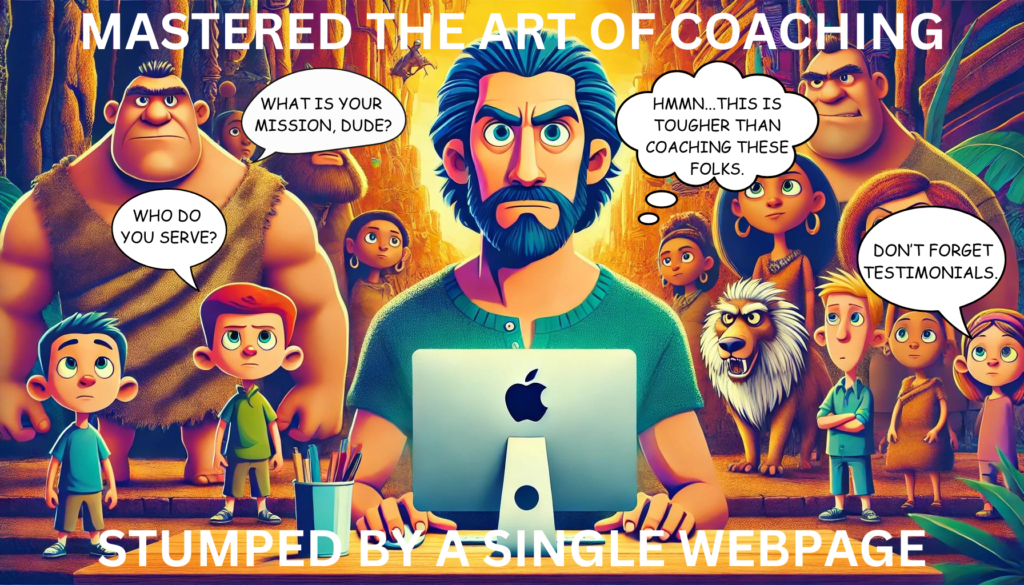“Your ‘About’ page is one of the most important pages on your website. It’s where you build trust with your audience by sharing your story and showing them who you are. Don’t underestimate its power.”
— Neil Patel, Digital Marketing Expert and Co-Founder of Crazy Egg, Hello Bar, and KISSmetrics
As a coach, your primary goal is to connect with and help your clients achieve their personal or professional aspirations. However, before you can start guiding them, they need to feel a sense of trust and connection with you. This is where your “About” page comes in. An effective “About” page does more than just provide information; it tells your story, showcases your expertise, and invites visitors to take the next step. In this guide, we will explore the critical elements that make an “About” page truly effective, helping you build a strong foundation for your coaching business online.
1. Compelling Introduction
Who You Are: Begin your “About” page with a brief introduction that captures who you are as a person and a professional. This should be a concise yet engaging summary that sets the tone for the rest of the page. For example, “Hi, I’m Jane Doe, a passionate life coach dedicated to helping individuals unlock their full potential.”
Personal Story: Sharing a short story or anecdote about your journey to becoming a coach adds a personal touch and makes your introduction more relatable. Describe a pivotal moment or experience that led you to the coaching profession, highlighting your passion and commitment to helping others. This narrative helps visitors see you as a real person with genuine motivations.
2. Your Mission and Values
Mission Statement: A clear and concise mission statement outlines your purpose as a coach. It communicates what drives you and what you aim to achieve with your clients. For instance, “My mission is to empower individuals to achieve their personal and professional goals through transformative coaching.”
Core Values: Sharing your core values helps potential clients understand your approach and principles. These values serve as the foundation of your coaching practice and guide your interactions with clients. Examples might include integrity, empathy, and growth. Explaining these values provides insight into what clients can expect when working with you.
3. Professional Background
Qualifications and Certifications: Listing your relevant qualifications, certifications, and training adds credibility and reassures clients of your expertise. Highlight any formal education, specialized training, or certifications from recognized institutions. This information establishes your authority and demonstrates your commitment to continuous learning.
Experience: Detailing your professional experience, particularly in the coaching field, further establishes your credibility. Include previous roles or experiences that contribute to your coaching practice, emphasizing any accomplishments or milestones. This section should paint a picture of your journey and growth as a professional.
4. Coaching Philosophy
Unique Approach: Explain your unique approach to coaching, highlighting what sets you apart from other coaches. Describe the methods and techniques you use and how they benefit your clients. For example, “I use a holistic approach that combines mindfulness techniques with actionable goal-setting strategies.”
Client Outcomes: Share the types of outcomes clients can expect from working with you. This helps set clear expectations and demonstrates your effectiveness as a coach. Provide examples of specific goals or challenges you’ve helped clients overcome, showcasing the real-world impact of your coaching.
5. Success Stories and Testimonials
Client Testimonials: Including testimonials from past clients is a powerful way to build trust. Positive feedback and success stories from real clients serve as social proof of your coaching abilities. Ensure that testimonials are specific and highlight tangible results, such as “Jane helped me achieve a work-life balance that I never thought possible.”
Case Studies: Briefly describe specific case studies where your coaching has made a significant difference. These can be anonymized to respect client privacy while still providing valuable insights into your process and results. Case studies add depth to your testimonials and illustrate the transformative power of your coaching.

6. Personal Connection
Personal Interests and Hobbies: Sharing a few personal details, such as your interests and hobbies, helps humanize you and makes it easier for potential clients to connect with you on a personal level. For example, “When I’m not coaching, you can find me hiking with my dog or practicing yoga.”
Photos: Include professional yet approachable photos of yourself. Seeing your face helps build a connection and trust, making you appear more relatable and accessible. Choose images that reflect your personality and style, such as candid shots of you engaging in activities you love.
7. Call to Action
Encourage Next Steps: Clearly guide visitors on what to do next. Whether it’s scheduling a consultation, downloading a resource, or contacting you, make the next step obvious and easy to follow. Use action-oriented language like “Schedule your free consultation today” or “Download our free guide to personal growth.”
Contact Information: Provide your contact information or a link to your contact page so potential clients can easily reach out. Make sure your contact details are up-to-date and easily accessible. This could include a contact form, email address, phone number, and social media links.
8. Professional Associations and Media Mentions
Affiliations: Listing any professional associations you are a part of adds to your credibility. Memberships in organizations like the International Coach Federation (ICF) or other reputable bodies indicate your commitment to professional standards and continuous development.
Media Features: Highlight any media mentions or publications you’ve been featured in. This further establishes your authority in your field and increases your visibility. Include logos of media outlets and links to the features if available.
9. Awards and Recognition
Awards: Mention any awards or recognitions you’ve received in your field. This serves as a testament to your skills and reputation. Awards can significantly boost your credibility and differentiate you from other coaches.
Recognition: Highlight any notable achievements or recognitions, such as being named a top coach in your area or receiving a prestigious industry accolade. This showcases your dedication and success in your coaching practice.
10. Social Proof
Social Media Links: Include links to your professional social media profiles. This allows potential clients to follow you and see your interactions and content. Social media presence can provide additional insights into your personality and coaching style.
Community Involvement: Share any involvement in community or charitable activities. This portrays you as someone who gives back and is involved beyond your professional work. It also aligns with your values and mission, further establishing your credibility and trustworthiness.
Conclusion
Your “About” page is more than just a section on your website; it’s an opportunity to connect with potential clients on a deeper level. By including these critical elements, you can create an “About” page that not only informs but also inspires trust and encourages visitors to take the next step. Remember, authenticity is key. Share your story, showcase your expertise, and let your passion for coaching shine through. A well-crafted “About” page can be a powerful tool in building a successful coaching practice.
Creating an effective “About” page requires careful thought and planning, but the effort is well worth it. As you implement these tips, you’ll find that your “About” page becomes a vital part of your online presence, helping you attract and connect with the clients who need your guidance the most.

